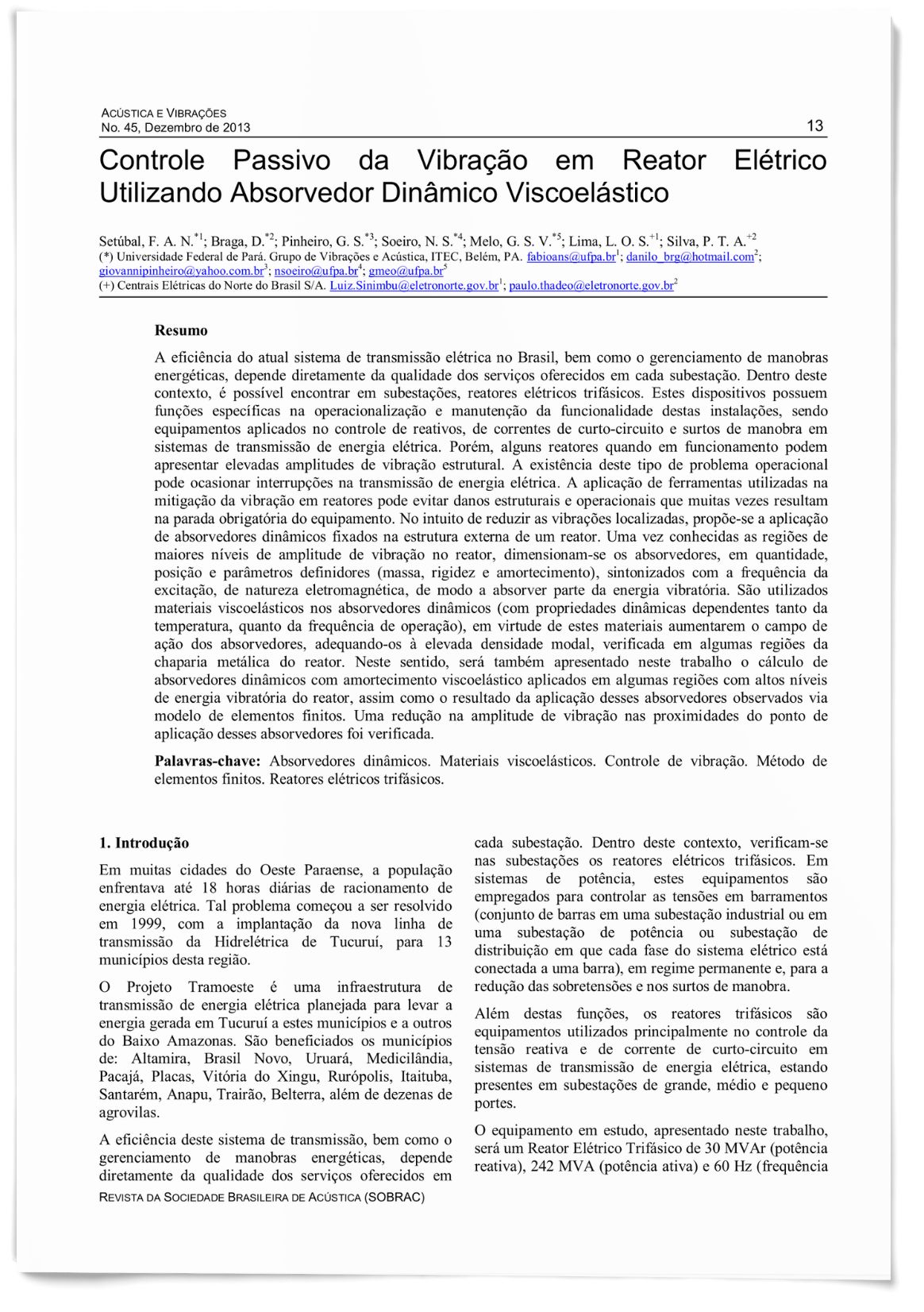Passive Vibration Control in Electric Reactor Using Viscoelastic Dynamic Absorber
DOI:
https://doi.org/10.55753/aev.v28e45.147Keywords:
Dynamic absorbers, Viscoelastic materials, Vibration control, Finite element method, three-phase electric ballastsAbstract
The efficiency of the current electrical transmission system in Brazil, as well as the management of energy maneuvers, depends directly on the quality of the services offered at each substation. Within this context, it is possible to find three-phase electrical reactors in substations. These devices have specific functions in the operation and maintenance of the functionality of these facilities, being equipment applied in the control of reactive, short-circuit currents and switching surges in electrical energy transmission systems. However, some reactors when in operation can present high amplitudes of structural vibration. The existence of this type of operational problem can cause interruptions in the transmission of electrical energy. The application of tools used in the mitigation of vibration in reactors can avoid structural and operational damage that often results in the mandatory stop of the equipment. In order to reduce localized vibrations, it is proposed to apply dynamic absorbers fixed to the external structure of a reactor. Once the regions with the highest vibration amplitude levels in the reactor are known, the absorbers are dimensioned in terms of quantity, position, and defining parameters (mass, stiffness, and damping), tuned to the excitation frequency, of an electromagnetic nature, in order to absorb part of the vibratory energy. Viscoelastic materials are used in dynamic absorbers (with dynamic properties dependent both on temperature and on the operating frequency), because these materials increase the field of action of the absorbers, adapting them to the high modal density, verified in some regions of the sheet metal. reactor metal. In this sense, it will also be presented in this work the calculation of dynamic absorbers with viscoelastic damping applied in some regions with high levels of vibratory energy in the reactor, as well as the result of the application of these absorbers observed via the finite element model. A reduction in the vibration amplitude in the vicinity of the application point of these absorbers was verified.
References
SOEIRO, N. S., et. al. (2000), Calculation of Eletromagnetic-mechanic-acoustic behavior of a squirrel-cage induction motor, Proceedings of the 2nd International Seminar on Vibrations and Acoustic Noise of Electric Machinery, Lodz (Polônia), 01-03 de junho.
ATALLA, N. and BERNHARD, R. J. (1994), Review of Numerical Solutions for Low-Frequency Structural-Acoustic Problems, Applied Acoustics 43, 271-294. doi: 10.1016/0003-682X(94)90050-7 DOI: https://doi.org/10.1016/0003-682X(94)90050-7
VLAHOPOULOS, N., RAVEENDRA, S. T. (1999), Numerical implementation and applications of a coupling algorithm for structural-acoustic models with unequal discretization and partially interfacing surfaces, Finite Elements in Analysis and Design 32, 257-277.v DOI: https://doi.org/10.1016/S0168-874X(99)00008-6
COYETTE, J. P. (1999), The use of finite-element and boundary-element models for predicting the vibro-acoustic behaviour of layered structures, Advances in Engineering Software 30,133-139. doi: /10.1016/S0965-9978(96)00041-5 DOI: https://doi.org/10.1016/S0965-9978(96)00041-5
SOEIRO, N. S., Uma metodologia de modelagem vibro-acústica de caixa de engrenagem de uso veicular. 2000. 237 f. Tese (Doutorado em Engenharia Mecânica). Universidade Federal de Santa Catarina, Florianópolis. 2000.
ALTSTADT, E. and WEISS, F. P. (1999), Finite element based vibration analysis of WWER-440 type reactors. Annals of Nuclear Energy 26,1037 - 1052. DOI: https://doi.org/10.1016/S0306-4549(99)00002-X
JOHNSON, C. D., Design of damping Systems, 2001.
BAVASTRI, C. A., Redução de Vibrações de Banda Larga em Estruturas Complexas por Neutralizadores Viscoelásticos, Tese de Doutorado, UFSC, 1997.
DEN HARTOG, J. P., Mechanical Vibrations, Dover Publications, 1985.
ABNT NBR 7569. Reatores para sistema de potência - Método de ensaio. 1982.

Published
How to Cite
Issue
Section
License
Copyright (c) 2013 Acústica e Vibrações

This work is licensed under a Creative Commons Attribution-NonCommercial-ShareAlike 4.0 International License.




